Gold Coast Commonwealth Games Beach Party Project Plan
VerifiedAdded on 2019/09/22
|64
|18445
|337
Project
AI Summary
This Project Management Plan (PMP) outlines the comprehensive project plan for the Commonwealth Games Beach Party, a social event held in Surfers Paradise during the 2018 Commonwealth Games. Created by ZYX Event Management and the Gold Coast City Council, the plan focuses on key project management areas, including integration, scope, schedule, cost, quality, human resources, communication, risk, and procurement management. It details the project's objectives, deliverables, constraints, and assumptions. The plan emphasizes the importance of effective governance, change management, and stakeholder engagement to ensure project success. Detailed sections cover scope management, including requirement gathering and work breakdown structure (WBS); schedule and cost management; quality assurance and control; human resource and communication strategies; and comprehensive risk and procurement management plans, including vendor management and performance metrics. Appendices provide supporting documentation, such as governance structures, change control procedures, WBS details, and risk registers, ensuring a robust and well-defined approach to project execution and delivery by the specified implementation date.

Commonwealth Games Beach Party
Paraphrase This Document
Need a fresh take? Get an instant paraphrase of this document with our AI Paraphraser
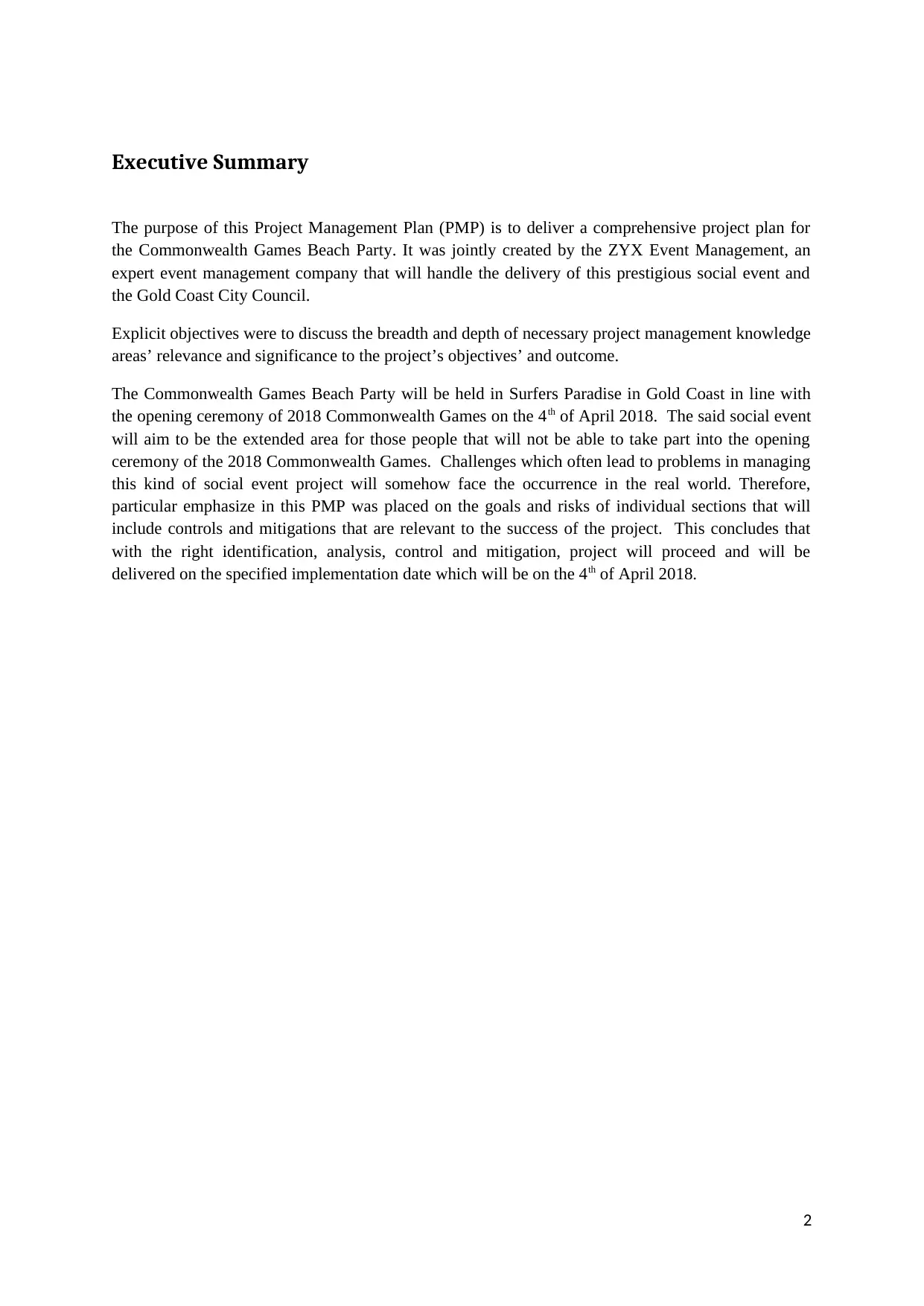
Executive Summary
The purpose of this Project Management Plan (PMP) is to deliver a comprehensive project plan for
the Commonwealth Games Beach Party. It was jointly created by the ZYX Event Management, an
expert event management company that will handle the delivery of this prestigious social event and
the Gold Coast City Council.
Explicit objectives were to discuss the breadth and depth of necessary project management knowledge
areas’ relevance and significance to the project’s objectives’ and outcome.
The Commonwealth Games Beach Party will be held in Surfers Paradise in Gold Coast in line with
the opening ceremony of 2018 Commonwealth Games on the 4th of April 2018. The said social event
will aim to be the extended area for those people that will not be able to take part into the opening
ceremony of the 2018 Commonwealth Games. Challenges which often lead to problems in managing
this kind of social event project will somehow face the occurrence in the real world. Therefore,
particular emphasize in this PMP was placed on the goals and risks of individual sections that will
include controls and mitigations that are relevant to the success of the project. This concludes that
with the right identification, analysis, control and mitigation, project will proceed and will be
delivered on the specified implementation date which will be on the 4th of April 2018.
2
The purpose of this Project Management Plan (PMP) is to deliver a comprehensive project plan for
the Commonwealth Games Beach Party. It was jointly created by the ZYX Event Management, an
expert event management company that will handle the delivery of this prestigious social event and
the Gold Coast City Council.
Explicit objectives were to discuss the breadth and depth of necessary project management knowledge
areas’ relevance and significance to the project’s objectives’ and outcome.
The Commonwealth Games Beach Party will be held in Surfers Paradise in Gold Coast in line with
the opening ceremony of 2018 Commonwealth Games on the 4th of April 2018. The said social event
will aim to be the extended area for those people that will not be able to take part into the opening
ceremony of the 2018 Commonwealth Games. Challenges which often lead to problems in managing
this kind of social event project will somehow face the occurrence in the real world. Therefore,
particular emphasize in this PMP was placed on the goals and risks of individual sections that will
include controls and mitigations that are relevant to the success of the project. This concludes that
with the right identification, analysis, control and mitigation, project will proceed and will be
delivered on the specified implementation date which will be on the 4th of April 2018.
2
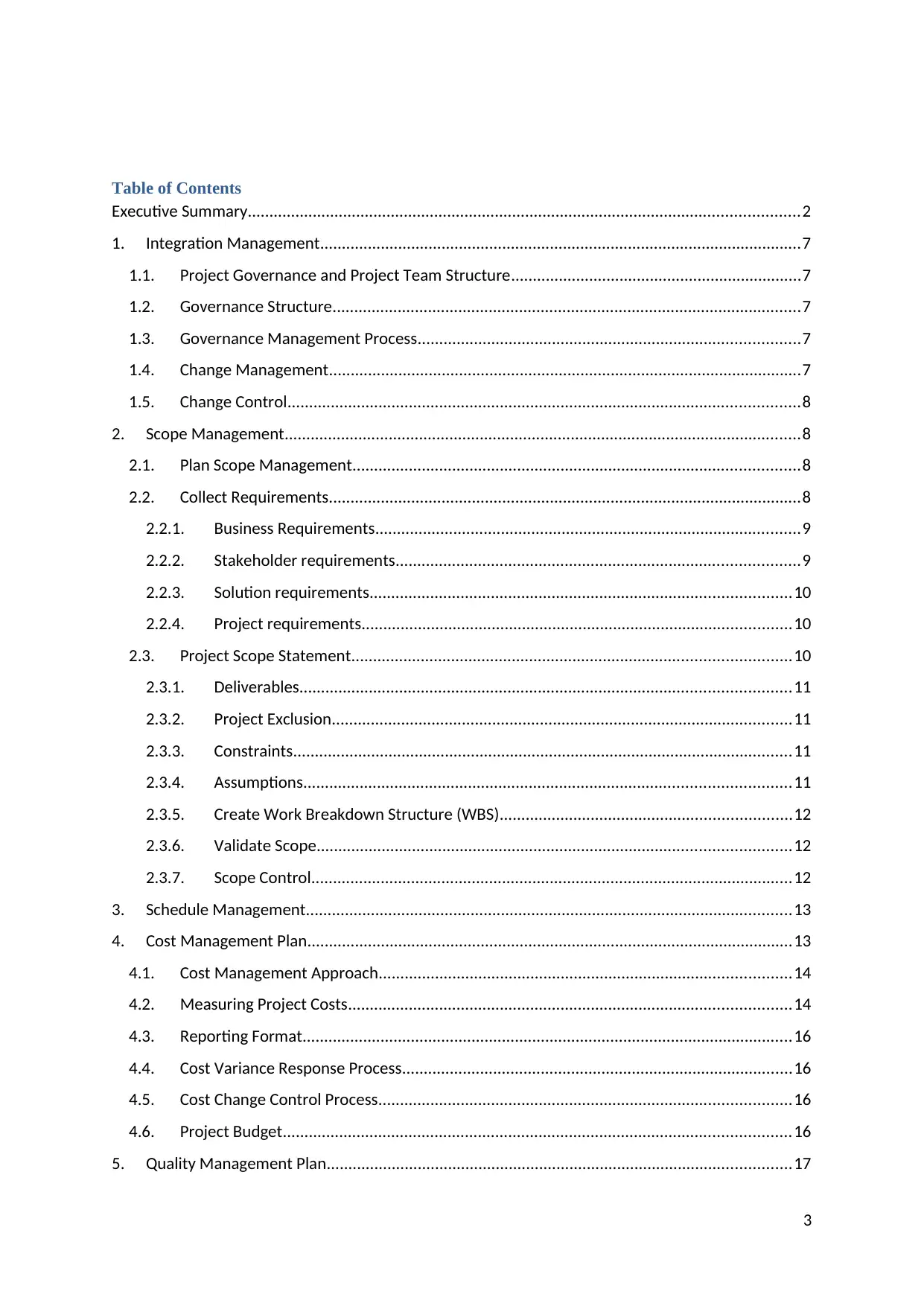
Table of Contents
Executive Summary...............................................................................................................................2
1. Integration Management...............................................................................................................7
1.1. Project Governance and Project Team Structure...................................................................7
1.2. Governance Structure............................................................................................................7
1.3. Governance Management Process........................................................................................7
1.4. Change Management.............................................................................................................7
1.5. Change Control......................................................................................................................8
2. Scope Management.......................................................................................................................8
2.1. Plan Scope Management.......................................................................................................8
2.2. Collect Requirements.............................................................................................................8
2.2.1. Business Requirements..................................................................................................9
2.2.2. Stakeholder requirements.............................................................................................9
2.2.3. Solution requirements.................................................................................................10
2.2.4. Project requirements...................................................................................................10
2.3. Project Scope Statement.....................................................................................................10
2.3.1. Deliverables.................................................................................................................11
2.3.2. Project Exclusion..........................................................................................................11
2.3.3. Constraints...................................................................................................................11
2.3.4. Assumptions................................................................................................................11
2.3.5. Create Work Breakdown Structure (WBS)...................................................................12
2.3.6. Validate Scope.............................................................................................................12
2.3.7. Scope Control...............................................................................................................12
3. Schedule Management................................................................................................................13
4. Cost Management Plan................................................................................................................13
4.1. Cost Management Approach...............................................................................................14
4.2. Measuring Project Costs......................................................................................................14
4.3. Reporting Format.................................................................................................................16
4.4. Cost Variance Response Process..........................................................................................16
4.5. Cost Change Control Process...............................................................................................16
4.6. Project Budget.....................................................................................................................16
5. Quality Management Plan...........................................................................................................17
3
Executive Summary...............................................................................................................................2
1. Integration Management...............................................................................................................7
1.1. Project Governance and Project Team Structure...................................................................7
1.2. Governance Structure............................................................................................................7
1.3. Governance Management Process........................................................................................7
1.4. Change Management.............................................................................................................7
1.5. Change Control......................................................................................................................8
2. Scope Management.......................................................................................................................8
2.1. Plan Scope Management.......................................................................................................8
2.2. Collect Requirements.............................................................................................................8
2.2.1. Business Requirements..................................................................................................9
2.2.2. Stakeholder requirements.............................................................................................9
2.2.3. Solution requirements.................................................................................................10
2.2.4. Project requirements...................................................................................................10
2.3. Project Scope Statement.....................................................................................................10
2.3.1. Deliverables.................................................................................................................11
2.3.2. Project Exclusion..........................................................................................................11
2.3.3. Constraints...................................................................................................................11
2.3.4. Assumptions................................................................................................................11
2.3.5. Create Work Breakdown Structure (WBS)...................................................................12
2.3.6. Validate Scope.............................................................................................................12
2.3.7. Scope Control...............................................................................................................12
3. Schedule Management................................................................................................................13
4. Cost Management Plan................................................................................................................13
4.1. Cost Management Approach...............................................................................................14
4.2. Measuring Project Costs......................................................................................................14
4.3. Reporting Format.................................................................................................................16
4.4. Cost Variance Response Process..........................................................................................16
4.5. Cost Change Control Process...............................................................................................16
4.6. Project Budget.....................................................................................................................16
5. Quality Management Plan...........................................................................................................17
3
⊘ This is a preview!⊘
Do you want full access?
Subscribe today to unlock all pages.

Trusted by 1+ million students worldwide
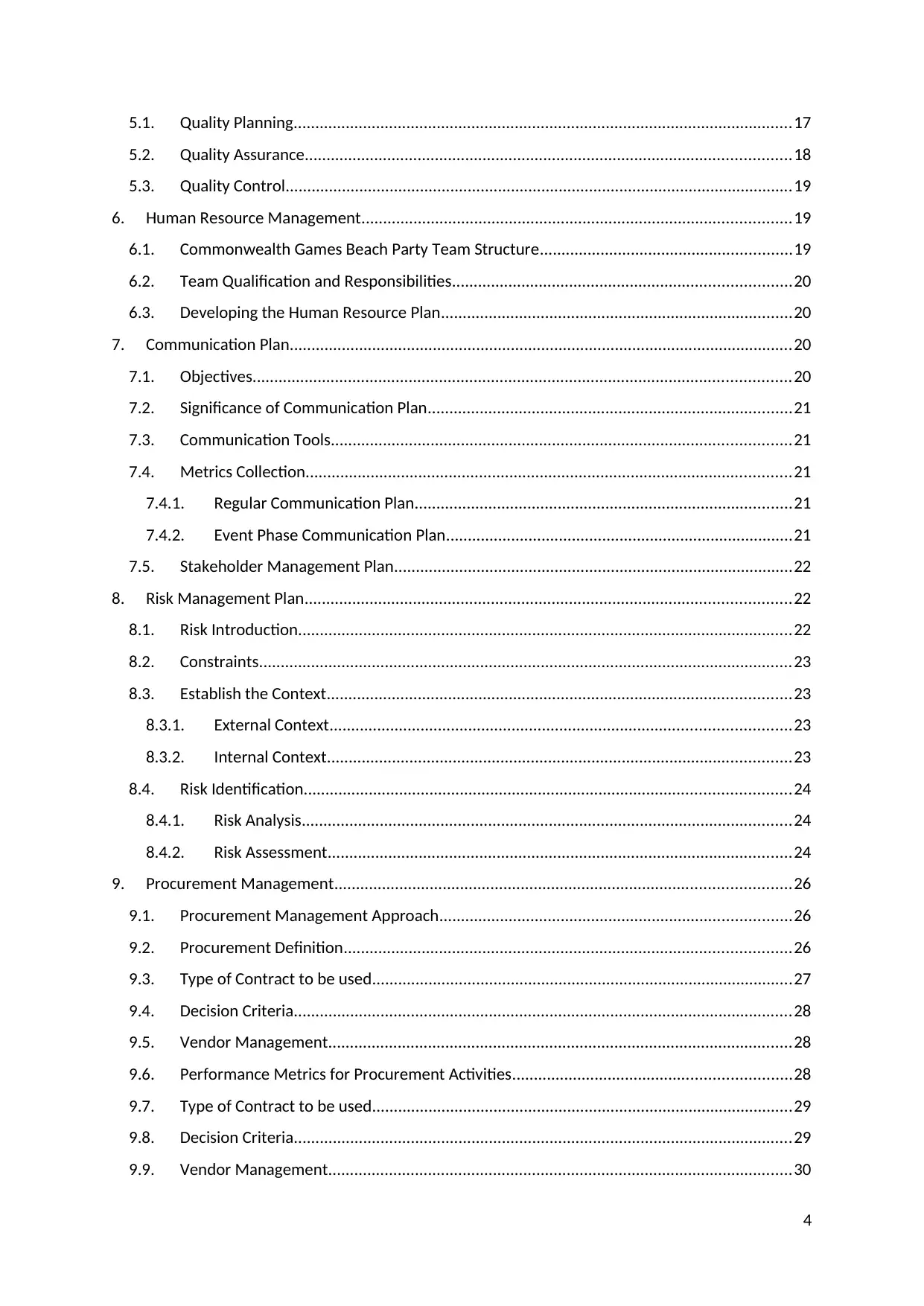
5.1. Quality Planning...................................................................................................................17
5.2. Quality Assurance................................................................................................................18
5.3. Quality Control.....................................................................................................................19
6. Human Resource Management...................................................................................................19
6.1. Commonwealth Games Beach Party Team Structure..........................................................19
6.2. Team Qualification and Responsibilities..............................................................................20
6.3. Developing the Human Resource Plan.................................................................................20
7. Communication Plan....................................................................................................................20
7.1. Objectives............................................................................................................................20
7.2. Significance of Communication Plan....................................................................................21
7.3. Communication Tools..........................................................................................................21
7.4. Metrics Collection................................................................................................................21
7.4.1. Regular Communication Plan.......................................................................................21
7.4.2. Event Phase Communication Plan................................................................................21
7.5. Stakeholder Management Plan............................................................................................22
8. Risk Management Plan................................................................................................................22
8.1. Risk Introduction..................................................................................................................22
8.2. Constraints...........................................................................................................................23
8.3. Establish the Context...........................................................................................................23
8.3.1. External Context..........................................................................................................23
8.3.2. Internal Context...........................................................................................................23
8.4. Risk Identification................................................................................................................24
8.4.1. Risk Analysis.................................................................................................................24
8.4.2. Risk Assessment...........................................................................................................24
9. Procurement Management.........................................................................................................26
9.1. Procurement Management Approach.................................................................................26
9.2. Procurement Definition.......................................................................................................26
9.3. Type of Contract to be used.................................................................................................27
9.4. Decision Criteria...................................................................................................................28
9.5. Vendor Management...........................................................................................................28
9.6. Performance Metrics for Procurement Activities................................................................28
9.7. Type of Contract to be used.................................................................................................29
9.8. Decision Criteria...................................................................................................................29
9.9. Vendor Management...........................................................................................................30
4
5.2. Quality Assurance................................................................................................................18
5.3. Quality Control.....................................................................................................................19
6. Human Resource Management...................................................................................................19
6.1. Commonwealth Games Beach Party Team Structure..........................................................19
6.2. Team Qualification and Responsibilities..............................................................................20
6.3. Developing the Human Resource Plan.................................................................................20
7. Communication Plan....................................................................................................................20
7.1. Objectives............................................................................................................................20
7.2. Significance of Communication Plan....................................................................................21
7.3. Communication Tools..........................................................................................................21
7.4. Metrics Collection................................................................................................................21
7.4.1. Regular Communication Plan.......................................................................................21
7.4.2. Event Phase Communication Plan................................................................................21
7.5. Stakeholder Management Plan............................................................................................22
8. Risk Management Plan................................................................................................................22
8.1. Risk Introduction..................................................................................................................22
8.2. Constraints...........................................................................................................................23
8.3. Establish the Context...........................................................................................................23
8.3.1. External Context..........................................................................................................23
8.3.2. Internal Context...........................................................................................................23
8.4. Risk Identification................................................................................................................24
8.4.1. Risk Analysis.................................................................................................................24
8.4.2. Risk Assessment...........................................................................................................24
9. Procurement Management.........................................................................................................26
9.1. Procurement Management Approach.................................................................................26
9.2. Procurement Definition.......................................................................................................26
9.3. Type of Contract to be used.................................................................................................27
9.4. Decision Criteria...................................................................................................................28
9.5. Vendor Management...........................................................................................................28
9.6. Performance Metrics for Procurement Activities................................................................28
9.7. Type of Contract to be used.................................................................................................29
9.8. Decision Criteria...................................................................................................................29
9.9. Vendor Management...........................................................................................................30
4
Paraphrase This Document
Need a fresh take? Get an instant paraphrase of this document with our AI Paraphraser
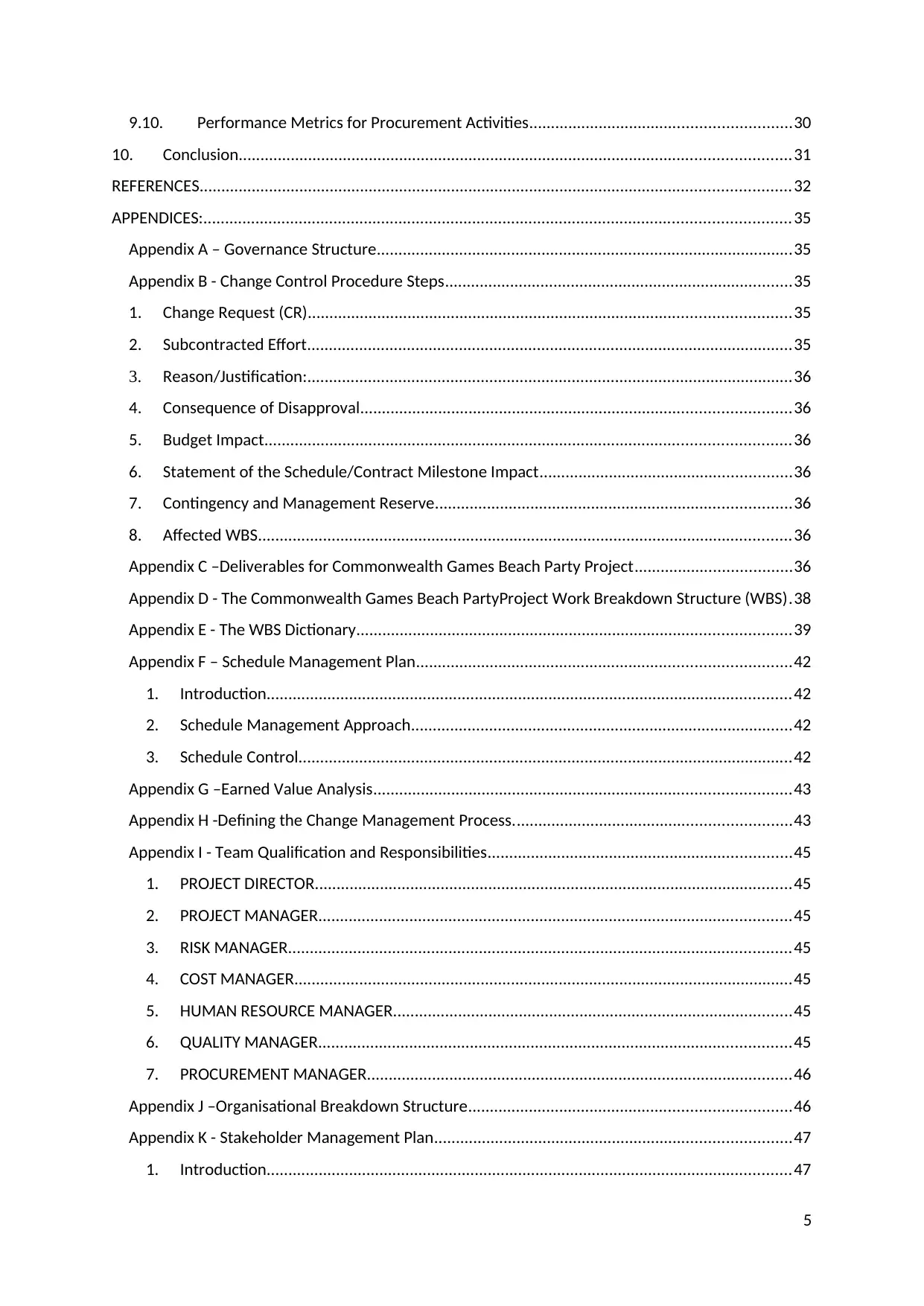
9.10. Performance Metrics for Procurement Activities............................................................30
10. Conclusion...............................................................................................................................31
REFERENCES........................................................................................................................................32
APPENDICES:.......................................................................................................................................35
Appendix A – Governance Structure................................................................................................35
Appendix B - Change Control Procedure Steps................................................................................35
1. Change Request (CR)...............................................................................................................35
2. Subcontracted Effort................................................................................................................35
3. Reason/Justification:................................................................................................................36
4. Consequence of Disapproval...................................................................................................36
5. Budget Impact.........................................................................................................................36
6. Statement of the Schedule/Contract Milestone Impact..........................................................36
7. Contingency and Management Reserve..................................................................................36
8. Affected WBS...........................................................................................................................36
Appendix C –Deliverables for Commonwealth Games Beach Party Project....................................36
Appendix D - The Commonwealth Games Beach PartyProject Work Breakdown Structure (WBS).38
Appendix E - The WBS Dictionary....................................................................................................39
Appendix F – Schedule Management Plan......................................................................................42
1. Introduction.........................................................................................................................42
2. Schedule Management Approach........................................................................................42
3. Schedule Control..................................................................................................................42
Appendix G –Earned Value Analysis................................................................................................43
Appendix H -Defining the Change Management Process................................................................43
Appendix I - Team Qualification and Responsibilities......................................................................45
1. PROJECT DIRECTOR..............................................................................................................45
2. PROJECT MANAGER.............................................................................................................45
3. RISK MANAGER....................................................................................................................45
4. COST MANAGER...................................................................................................................45
5. HUMAN RESOURCE MANAGER............................................................................................45
6. QUALITY MANAGER.............................................................................................................45
7. PROCUREMENT MANAGER..................................................................................................46
Appendix J –Organisational Breakdown Structure..........................................................................46
Appendix K - Stakeholder Management Plan..................................................................................47
1. Introduction.........................................................................................................................47
5
10. Conclusion...............................................................................................................................31
REFERENCES........................................................................................................................................32
APPENDICES:.......................................................................................................................................35
Appendix A – Governance Structure................................................................................................35
Appendix B - Change Control Procedure Steps................................................................................35
1. Change Request (CR)...............................................................................................................35
2. Subcontracted Effort................................................................................................................35
3. Reason/Justification:................................................................................................................36
4. Consequence of Disapproval...................................................................................................36
5. Budget Impact.........................................................................................................................36
6. Statement of the Schedule/Contract Milestone Impact..........................................................36
7. Contingency and Management Reserve..................................................................................36
8. Affected WBS...........................................................................................................................36
Appendix C –Deliverables for Commonwealth Games Beach Party Project....................................36
Appendix D - The Commonwealth Games Beach PartyProject Work Breakdown Structure (WBS).38
Appendix E - The WBS Dictionary....................................................................................................39
Appendix F – Schedule Management Plan......................................................................................42
1. Introduction.........................................................................................................................42
2. Schedule Management Approach........................................................................................42
3. Schedule Control..................................................................................................................42
Appendix G –Earned Value Analysis................................................................................................43
Appendix H -Defining the Change Management Process................................................................43
Appendix I - Team Qualification and Responsibilities......................................................................45
1. PROJECT DIRECTOR..............................................................................................................45
2. PROJECT MANAGER.............................................................................................................45
3. RISK MANAGER....................................................................................................................45
4. COST MANAGER...................................................................................................................45
5. HUMAN RESOURCE MANAGER............................................................................................45
6. QUALITY MANAGER.............................................................................................................45
7. PROCUREMENT MANAGER..................................................................................................46
Appendix J –Organisational Breakdown Structure..........................................................................46
Appendix K - Stakeholder Management Plan..................................................................................47
1. Introduction.........................................................................................................................47
5
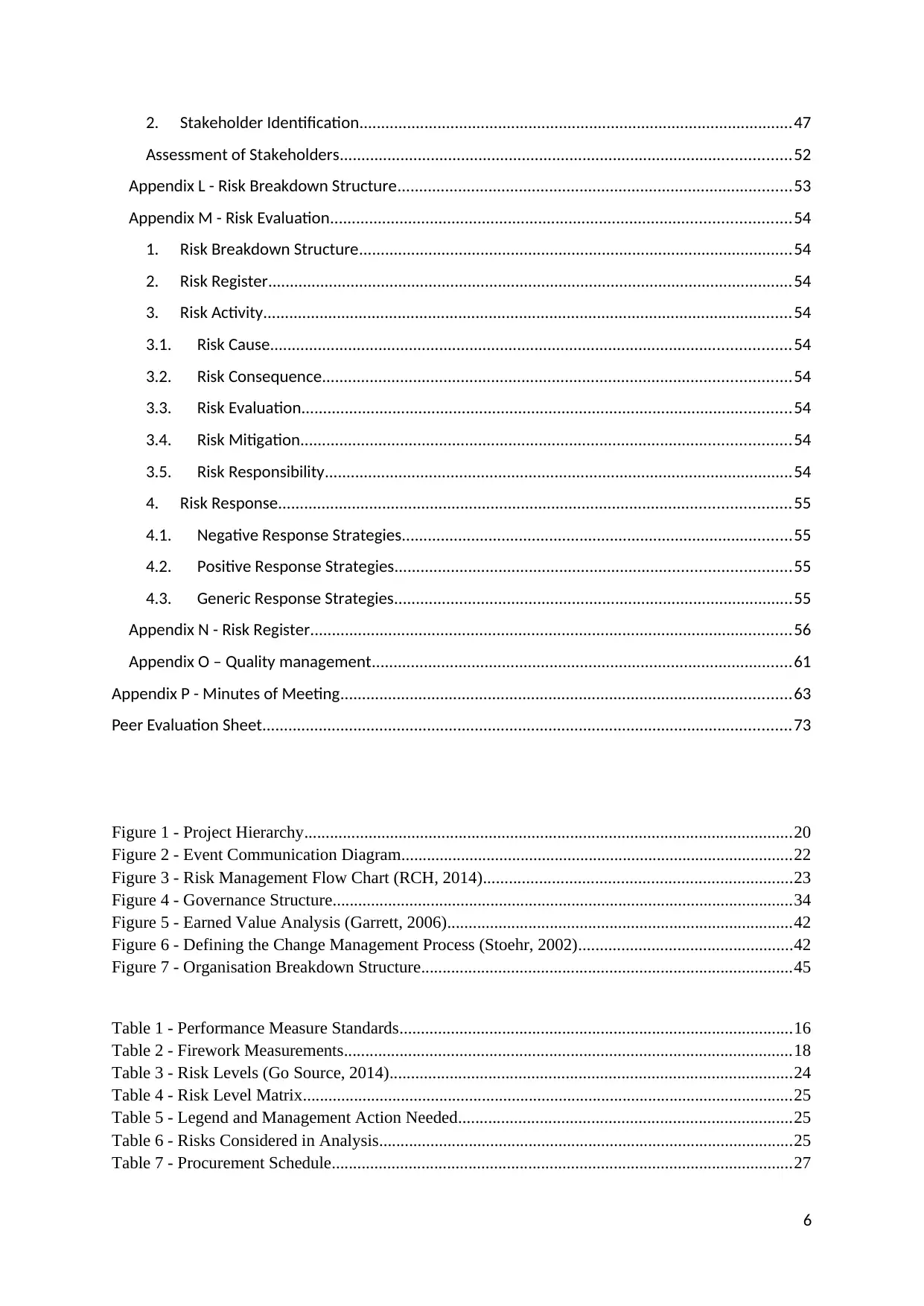
2. Stakeholder Identification....................................................................................................47
Assessment of Stakeholders........................................................................................................52
Appendix L - Risk Breakdown Structure...........................................................................................53
Appendix M - Risk Evaluation..........................................................................................................54
1. Risk Breakdown Structure....................................................................................................54
2. Risk Register.........................................................................................................................54
3. Risk Activity..........................................................................................................................54
3.1. Risk Cause........................................................................................................................54
3.2. Risk Consequence............................................................................................................54
3.3. Risk Evaluation.................................................................................................................54
3.4. Risk Mitigation.................................................................................................................54
3.5. Risk Responsibility............................................................................................................54
4. Risk Response......................................................................................................................55
4.1. Negative Response Strategies..........................................................................................55
4.2. Positive Response Strategies...........................................................................................55
4.3. Generic Response Strategies............................................................................................55
Appendix N - Risk Register...............................................................................................................56
Appendix O – Quality management.................................................................................................61
Appendix P - Minutes of Meeting........................................................................................................63
Peer Evaluation Sheet..........................................................................................................................73
Figure 1 - Project Hierarchy..................................................................................................................20
Figure 2 - Event Communication Diagram............................................................................................22
Figure 3 - Risk Management Flow Chart (RCH, 2014)........................................................................23
Figure 4 - Governance Structure............................................................................................................34
Figure 5 - Earned Value Analysis (Garrett, 2006).................................................................................42
Figure 6 - Defining the Change Management Process (Stoehr, 2002)..................................................42
Figure 7 - Organisation Breakdown Structure.......................................................................................45
Table 1 - Performance Measure Standards............................................................................................16
Table 2 - Firework Measurements.........................................................................................................18
Table 3 - Risk Levels (Go Source, 2014)..............................................................................................24
Table 4 - Risk Level Matrix...................................................................................................................25
Table 5 - Legend and Management Action Needed..............................................................................25
Table 6 - Risks Considered in Analysis.................................................................................................25
Table 7 - Procurement Schedule............................................................................................................27
6
Assessment of Stakeholders........................................................................................................52
Appendix L - Risk Breakdown Structure...........................................................................................53
Appendix M - Risk Evaluation..........................................................................................................54
1. Risk Breakdown Structure....................................................................................................54
2. Risk Register.........................................................................................................................54
3. Risk Activity..........................................................................................................................54
3.1. Risk Cause........................................................................................................................54
3.2. Risk Consequence............................................................................................................54
3.3. Risk Evaluation.................................................................................................................54
3.4. Risk Mitigation.................................................................................................................54
3.5. Risk Responsibility............................................................................................................54
4. Risk Response......................................................................................................................55
4.1. Negative Response Strategies..........................................................................................55
4.2. Positive Response Strategies...........................................................................................55
4.3. Generic Response Strategies............................................................................................55
Appendix N - Risk Register...............................................................................................................56
Appendix O – Quality management.................................................................................................61
Appendix P - Minutes of Meeting........................................................................................................63
Peer Evaluation Sheet..........................................................................................................................73
Figure 1 - Project Hierarchy..................................................................................................................20
Figure 2 - Event Communication Diagram............................................................................................22
Figure 3 - Risk Management Flow Chart (RCH, 2014)........................................................................23
Figure 4 - Governance Structure............................................................................................................34
Figure 5 - Earned Value Analysis (Garrett, 2006).................................................................................42
Figure 6 - Defining the Change Management Process (Stoehr, 2002)..................................................42
Figure 7 - Organisation Breakdown Structure.......................................................................................45
Table 1 - Performance Measure Standards............................................................................................16
Table 2 - Firework Measurements.........................................................................................................18
Table 3 - Risk Levels (Go Source, 2014)..............................................................................................24
Table 4 - Risk Level Matrix...................................................................................................................25
Table 5 - Legend and Management Action Needed..............................................................................25
Table 6 - Risks Considered in Analysis.................................................................................................25
Table 7 - Procurement Schedule............................................................................................................27
6
⊘ This is a preview!⊘
Do you want full access?
Subscribe today to unlock all pages.

Trusted by 1+ million students worldwide
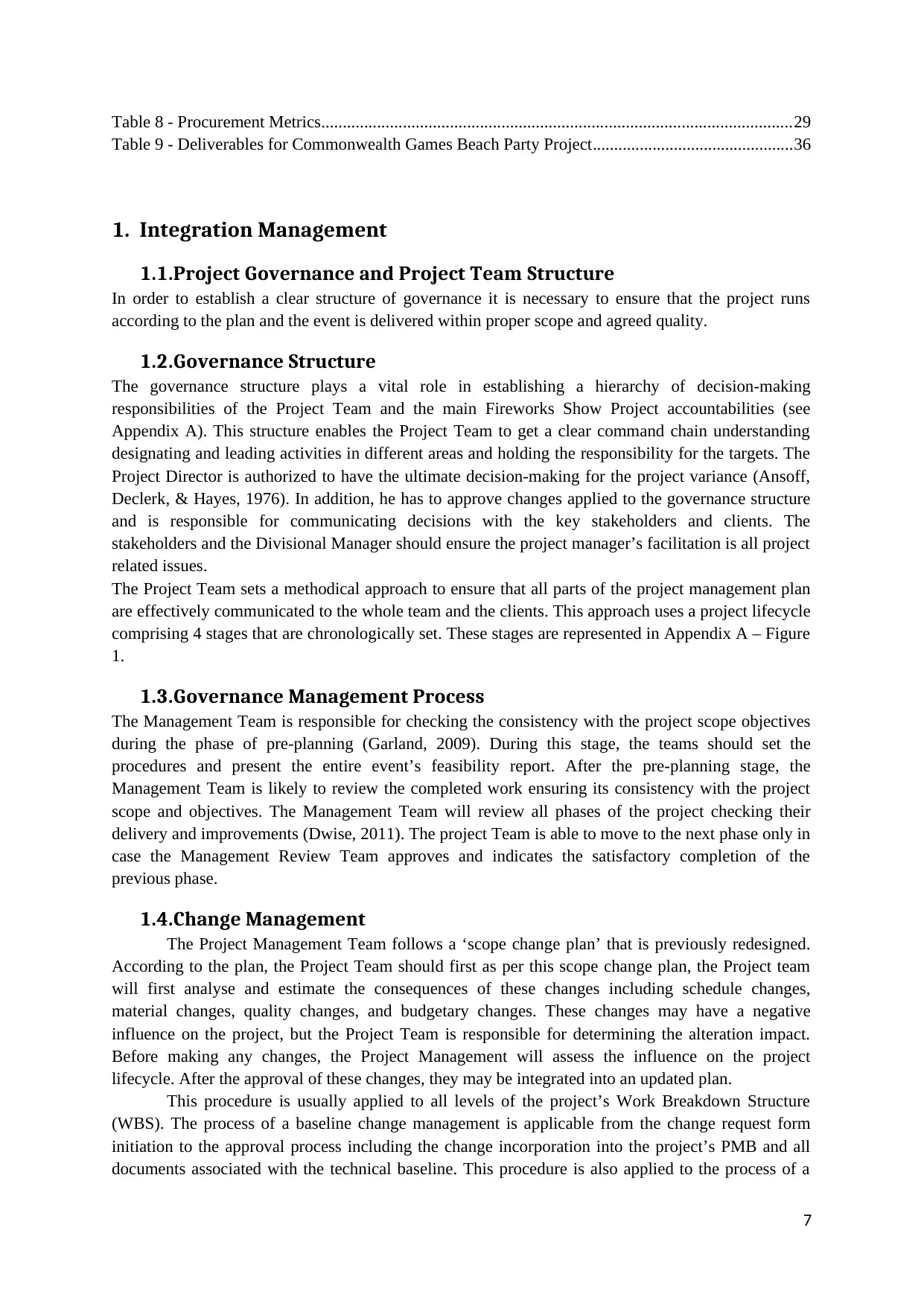
Table 8 - Procurement Metrics..............................................................................................................29
Table 9 - Deliverables for Commonwealth Games Beach Party Project...............................................36
1. Integration Management
1.1.Project Governance and Project Team Structure
In order to establish a clear structure of governance it is necessary to ensure that the project runs
according to the plan and the event is delivered within proper scope and agreed quality.
1.2.Governance Structure
The governance structure plays a vital role in establishing a hierarchy of decision-making
responsibilities of the Project Team and the main Fireworks Show Project accountabilities (see
Appendix A). This structure enables the Project Team to get a clear command chain understanding
designating and leading activities in different areas and holding the responsibility for the targets. The
Project Director is authorized to have the ultimate decision-making for the project variance (Ansoff,
Declerk, & Hayes, 1976). In addition, he has to approve changes applied to the governance structure
and is responsible for communicating decisions with the key stakeholders and clients. The
stakeholders and the Divisional Manager should ensure the project manager’s facilitation is all project
related issues.
The Project Team sets a methodical approach to ensure that all parts of the project management plan
are effectively communicated to the whole team and the clients. This approach uses a project lifecycle
comprising 4 stages that are chronologically set. These stages are represented in Appendix A – Figure
1.
1.3.Governance Management Process
The Management Team is responsible for checking the consistency with the project scope objectives
during the phase of pre-planning (Garland, 2009). During this stage, the teams should set the
procedures and present the entire event’s feasibility report. After the pre-planning stage, the
Management Team is likely to review the completed work ensuring its consistency with the project
scope and objectives. The Management Team will review all phases of the project checking their
delivery and improvements (Dwise, 2011). The project Team is able to move to the next phase only in
case the Management Review Team approves and indicates the satisfactory completion of the
previous phase.
1.4.Change Management
The Project Management Team follows a ‘scope change plan’ that is previously redesigned.
According to the plan, the Project Team should first as per this scope change plan, the Project team
will first analyse and estimate the consequences of these changes including schedule changes,
material changes, quality changes, and budgetary changes. These changes may have a negative
influence on the project, but the Project Team is responsible for determining the alteration impact.
Before making any changes, the Project Management will assess the influence on the project
lifecycle. After the approval of these changes, they may be integrated into an updated plan.
This procedure is usually applied to all levels of the project’s Work Breakdown Structure
(WBS). The process of a baseline change management is applicable from the change request form
initiation to the approval process including the change incorporation into the project’s PMB and all
documents associated with the technical baseline. This procedure is also applied to the process of a
7
Table 9 - Deliverables for Commonwealth Games Beach Party Project...............................................36
1. Integration Management
1.1.Project Governance and Project Team Structure
In order to establish a clear structure of governance it is necessary to ensure that the project runs
according to the plan and the event is delivered within proper scope and agreed quality.
1.2.Governance Structure
The governance structure plays a vital role in establishing a hierarchy of decision-making
responsibilities of the Project Team and the main Fireworks Show Project accountabilities (see
Appendix A). This structure enables the Project Team to get a clear command chain understanding
designating and leading activities in different areas and holding the responsibility for the targets. The
Project Director is authorized to have the ultimate decision-making for the project variance (Ansoff,
Declerk, & Hayes, 1976). In addition, he has to approve changes applied to the governance structure
and is responsible for communicating decisions with the key stakeholders and clients. The
stakeholders and the Divisional Manager should ensure the project manager’s facilitation is all project
related issues.
The Project Team sets a methodical approach to ensure that all parts of the project management plan
are effectively communicated to the whole team and the clients. This approach uses a project lifecycle
comprising 4 stages that are chronologically set. These stages are represented in Appendix A – Figure
1.
1.3.Governance Management Process
The Management Team is responsible for checking the consistency with the project scope objectives
during the phase of pre-planning (Garland, 2009). During this stage, the teams should set the
procedures and present the entire event’s feasibility report. After the pre-planning stage, the
Management Team is likely to review the completed work ensuring its consistency with the project
scope and objectives. The Management Team will review all phases of the project checking their
delivery and improvements (Dwise, 2011). The project Team is able to move to the next phase only in
case the Management Review Team approves and indicates the satisfactory completion of the
previous phase.
1.4.Change Management
The Project Management Team follows a ‘scope change plan’ that is previously redesigned.
According to the plan, the Project Team should first as per this scope change plan, the Project team
will first analyse and estimate the consequences of these changes including schedule changes,
material changes, quality changes, and budgetary changes. These changes may have a negative
influence on the project, but the Project Team is responsible for determining the alteration impact.
Before making any changes, the Project Management will assess the influence on the project
lifecycle. After the approval of these changes, they may be integrated into an updated plan.
This procedure is usually applied to all levels of the project’s Work Breakdown Structure
(WBS). The process of a baseline change management is applicable from the change request form
initiation to the approval process including the change incorporation into the project’s PMB and all
documents associated with the technical baseline. This procedure is also applied to the process of a
7
Paraphrase This Document
Need a fresh take? Get an instant paraphrase of this document with our AI Paraphraser
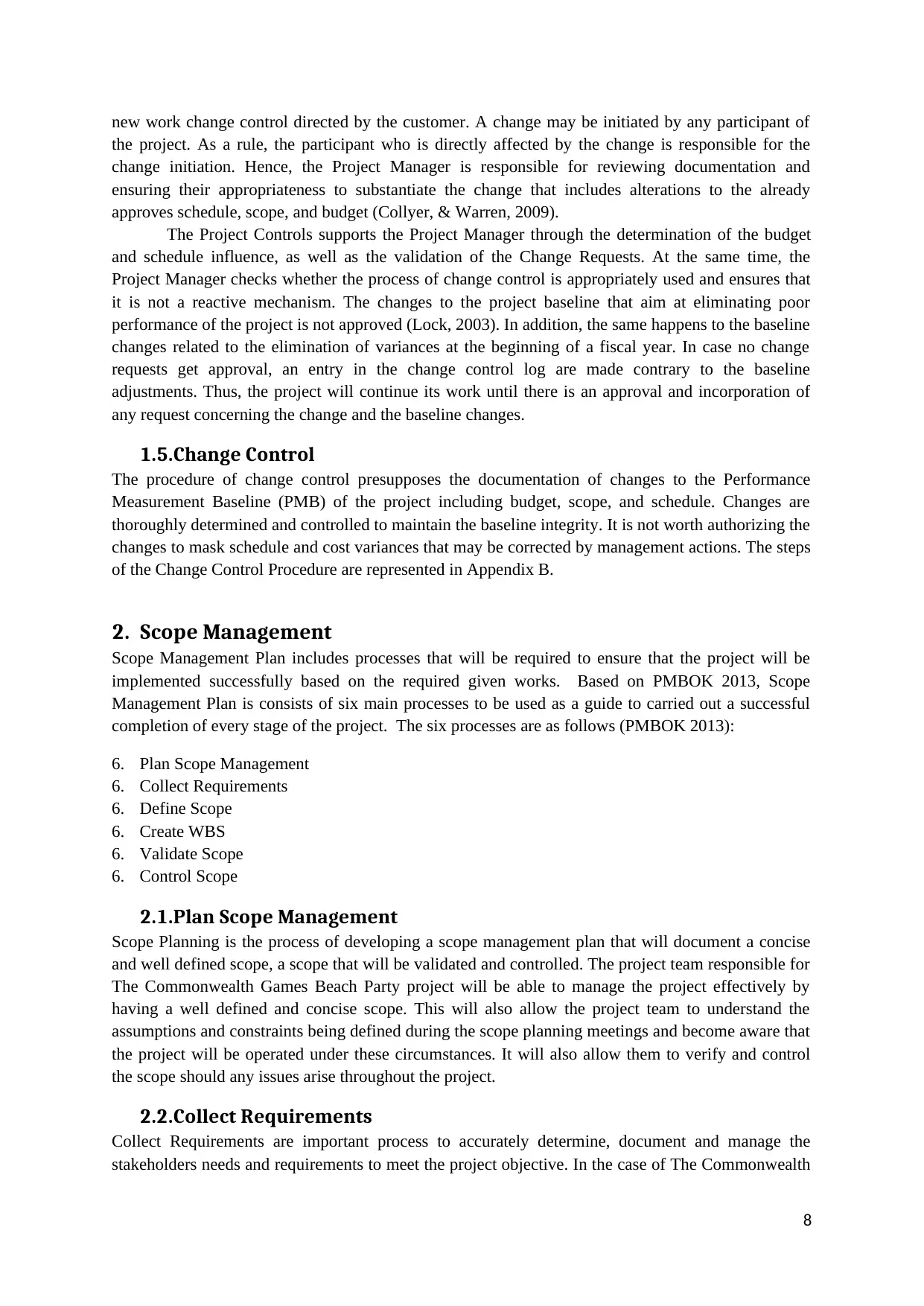
new work change control directed by the customer. A change may be initiated by any participant of
the project. As a rule, the participant who is directly affected by the change is responsible for the
change initiation. Hence, the Project Manager is responsible for reviewing documentation and
ensuring their appropriateness to substantiate the change that includes alterations to the already
approves schedule, scope, and budget (Collyer, & Warren, 2009).
The Project Controls supports the Project Manager through the determination of the budget
and schedule influence, as well as the validation of the Change Requests. At the same time, the
Project Manager checks whether the process of change control is appropriately used and ensures that
it is not a reactive mechanism. The changes to the project baseline that aim at eliminating poor
performance of the project is not approved (Lock, 2003). In addition, the same happens to the baseline
changes related to the elimination of variances at the beginning of a fiscal year. In case no change
requests get approval, an entry in the change control log are made contrary to the baseline
adjustments. Thus, the project will continue its work until there is an approval and incorporation of
any request concerning the change and the baseline changes.
1.5.Change Control
The procedure of change control presupposes the documentation of changes to the Performance
Measurement Baseline (PMB) of the project including budget, scope, and schedule. Changes are
thoroughly determined and controlled to maintain the baseline integrity. It is not worth authorizing the
changes to mask schedule and cost variances that may be corrected by management actions. The steps
of the Change Control Procedure are represented in Appendix B.
2. Scope Management
Scope Management Plan includes processes that will be required to ensure that the project will be
implemented successfully based on the required given works. Based on PMBOK 2013, Scope
Management Plan is consists of six main processes to be used as a guide to carried out a successful
completion of every stage of the project. The six processes are as follows (PMBOK 2013):
6. Plan Scope Management
6. Collect Requirements
6. Define Scope
6. Create WBS
6. Validate Scope
6. Control Scope
2.1.Plan Scope Management
Scope Planning is the process of developing a scope management plan that will document a concise
and well defined scope, a scope that will be validated and controlled. The project team responsible for
The Commonwealth Games Beach Party project will be able to manage the project effectively by
having a well defined and concise scope. This will also allow the project team to understand the
assumptions and constraints being defined during the scope planning meetings and become aware that
the project will be operated under these circumstances. It will also allow them to verify and control
the scope should any issues arise throughout the project.
2.2.Collect Requirements
Collect Requirements are important process to accurately determine, document and manage the
stakeholders needs and requirements to meet the project objective. In the case of The Commonwealth
8
the project. As a rule, the participant who is directly affected by the change is responsible for the
change initiation. Hence, the Project Manager is responsible for reviewing documentation and
ensuring their appropriateness to substantiate the change that includes alterations to the already
approves schedule, scope, and budget (Collyer, & Warren, 2009).
The Project Controls supports the Project Manager through the determination of the budget
and schedule influence, as well as the validation of the Change Requests. At the same time, the
Project Manager checks whether the process of change control is appropriately used and ensures that
it is not a reactive mechanism. The changes to the project baseline that aim at eliminating poor
performance of the project is not approved (Lock, 2003). In addition, the same happens to the baseline
changes related to the elimination of variances at the beginning of a fiscal year. In case no change
requests get approval, an entry in the change control log are made contrary to the baseline
adjustments. Thus, the project will continue its work until there is an approval and incorporation of
any request concerning the change and the baseline changes.
1.5.Change Control
The procedure of change control presupposes the documentation of changes to the Performance
Measurement Baseline (PMB) of the project including budget, scope, and schedule. Changes are
thoroughly determined and controlled to maintain the baseline integrity. It is not worth authorizing the
changes to mask schedule and cost variances that may be corrected by management actions. The steps
of the Change Control Procedure are represented in Appendix B.
2. Scope Management
Scope Management Plan includes processes that will be required to ensure that the project will be
implemented successfully based on the required given works. Based on PMBOK 2013, Scope
Management Plan is consists of six main processes to be used as a guide to carried out a successful
completion of every stage of the project. The six processes are as follows (PMBOK 2013):
6. Plan Scope Management
6. Collect Requirements
6. Define Scope
6. Create WBS
6. Validate Scope
6. Control Scope
2.1.Plan Scope Management
Scope Planning is the process of developing a scope management plan that will document a concise
and well defined scope, a scope that will be validated and controlled. The project team responsible for
The Commonwealth Games Beach Party project will be able to manage the project effectively by
having a well defined and concise scope. This will also allow the project team to understand the
assumptions and constraints being defined during the scope planning meetings and become aware that
the project will be operated under these circumstances. It will also allow them to verify and control
the scope should any issues arise throughout the project.
2.2.Collect Requirements
Collect Requirements are important process to accurately determine, document and manage the
stakeholders needs and requirements to meet the project objective. In the case of The Commonwealth
8
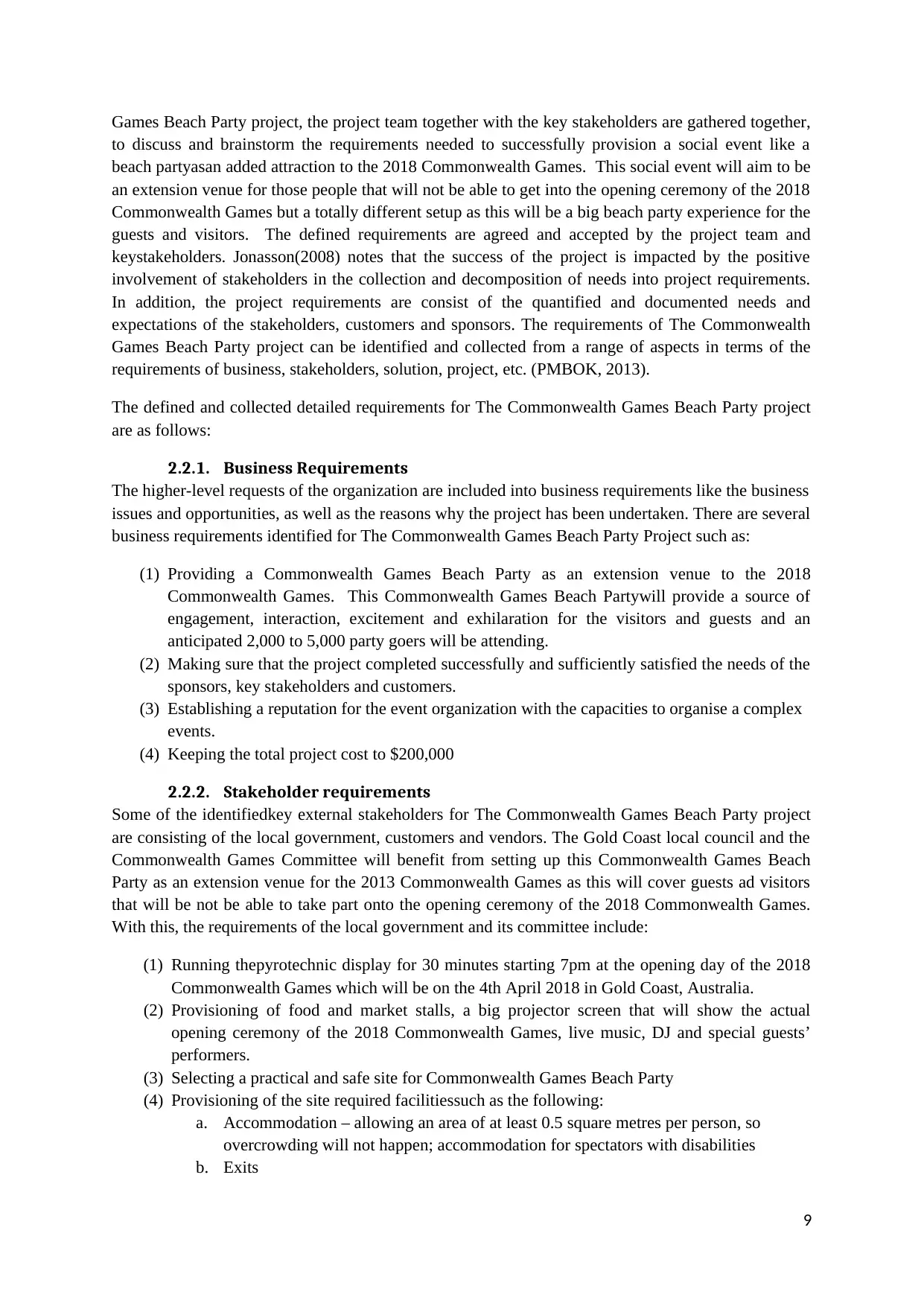
Games Beach Party project, the project team together with the key stakeholders are gathered together,
to discuss and brainstorm the requirements needed to successfully provision a social event like a
beach partyasan added attraction to the 2018 Commonwealth Games. This social event will aim to be
an extension venue for those people that will not be able to get into the opening ceremony of the 2018
Commonwealth Games but a totally different setup as this will be a big beach party experience for the
guests and visitors. The defined requirements are agreed and accepted by the project team and
keystakeholders. Jonasson(2008) notes that the success of the project is impacted by the positive
involvement of stakeholders in the collection and decomposition of needs into project requirements.
In addition, the project requirements are consist of the quantified and documented needs and
expectations of the stakeholders, customers and sponsors. The requirements of The Commonwealth
Games Beach Party project can be identified and collected from a range of aspects in terms of the
requirements of business, stakeholders, solution, project, etc. (PMBOK, 2013).
The defined and collected detailed requirements for The Commonwealth Games Beach Party project
are as follows:
2.2.1. Business Requirements
The higher-level requests of the organization are included into business requirements like the business
issues and opportunities, as well as the reasons why the project has been undertaken. There are several
business requirements identified for The Commonwealth Games Beach Party Project such as:
(1) Providing a Commonwealth Games Beach Party as an extension venue to the 2018
Commonwealth Games. This Commonwealth Games Beach Partywill provide a source of
engagement, interaction, excitement and exhilaration for the visitors and guests and an
anticipated 2,000 to 5,000 party goers will be attending.
(2) Making sure that the project completed successfully and sufficiently satisfied the needs of the
sponsors, key stakeholders and customers.
(3) Establishing a reputation for the event organization with the capacities to organise a complex
events.
(4) Keeping the total project cost to $200,000
2.2.2. Stakeholder requirements
Some of the identifiedkey external stakeholders for The Commonwealth Games Beach Party project
are consisting of the local government, customers and vendors. The Gold Coast local council and the
Commonwealth Games Committee will benefit from setting up this Commonwealth Games Beach
Party as an extension venue for the 2013 Commonwealth Games as this will cover guests ad visitors
that will be not be able to take part onto the opening ceremony of the 2018 Commonwealth Games.
With this, the requirements of the local government and its committee include:
(1) Running thepyrotechnic display for 30 minutes starting 7pm at the opening day of the 2018
Commonwealth Games which will be on the 4th April 2018 in Gold Coast, Australia.
(2) Provisioning of food and market stalls, a big projector screen that will show the actual
opening ceremony of the 2018 Commonwealth Games, live music, DJ and special guests’
performers.
(3) Selecting a practical and safe site for Commonwealth Games Beach Party
(4) Provisioning of the site required facilitiessuch as the following:
a. Accommodation – allowing an area of at least 0.5 square metres per person, so
overcrowding will not happen; accommodation for spectators with disabilities
b. Exits
9
to discuss and brainstorm the requirements needed to successfully provision a social event like a
beach partyasan added attraction to the 2018 Commonwealth Games. This social event will aim to be
an extension venue for those people that will not be able to get into the opening ceremony of the 2018
Commonwealth Games but a totally different setup as this will be a big beach party experience for the
guests and visitors. The defined requirements are agreed and accepted by the project team and
keystakeholders. Jonasson(2008) notes that the success of the project is impacted by the positive
involvement of stakeholders in the collection and decomposition of needs into project requirements.
In addition, the project requirements are consist of the quantified and documented needs and
expectations of the stakeholders, customers and sponsors. The requirements of The Commonwealth
Games Beach Party project can be identified and collected from a range of aspects in terms of the
requirements of business, stakeholders, solution, project, etc. (PMBOK, 2013).
The defined and collected detailed requirements for The Commonwealth Games Beach Party project
are as follows:
2.2.1. Business Requirements
The higher-level requests of the organization are included into business requirements like the business
issues and opportunities, as well as the reasons why the project has been undertaken. There are several
business requirements identified for The Commonwealth Games Beach Party Project such as:
(1) Providing a Commonwealth Games Beach Party as an extension venue to the 2018
Commonwealth Games. This Commonwealth Games Beach Partywill provide a source of
engagement, interaction, excitement and exhilaration for the visitors and guests and an
anticipated 2,000 to 5,000 party goers will be attending.
(2) Making sure that the project completed successfully and sufficiently satisfied the needs of the
sponsors, key stakeholders and customers.
(3) Establishing a reputation for the event organization with the capacities to organise a complex
events.
(4) Keeping the total project cost to $200,000
2.2.2. Stakeholder requirements
Some of the identifiedkey external stakeholders for The Commonwealth Games Beach Party project
are consisting of the local government, customers and vendors. The Gold Coast local council and the
Commonwealth Games Committee will benefit from setting up this Commonwealth Games Beach
Party as an extension venue for the 2013 Commonwealth Games as this will cover guests ad visitors
that will be not be able to take part onto the opening ceremony of the 2018 Commonwealth Games.
With this, the requirements of the local government and its committee include:
(1) Running thepyrotechnic display for 30 minutes starting 7pm at the opening day of the 2018
Commonwealth Games which will be on the 4th April 2018 in Gold Coast, Australia.
(2) Provisioning of food and market stalls, a big projector screen that will show the actual
opening ceremony of the 2018 Commonwealth Games, live music, DJ and special guests’
performers.
(3) Selecting a practical and safe site for Commonwealth Games Beach Party
(4) Provisioning of the site required facilitiessuch as the following:
a. Accommodation – allowing an area of at least 0.5 square metres per person, so
overcrowding will not happen; accommodation for spectators with disabilities
b. Exits
9
⊘ This is a preview!⊘
Do you want full access?
Subscribe today to unlock all pages.

Trusted by 1+ million students worldwide
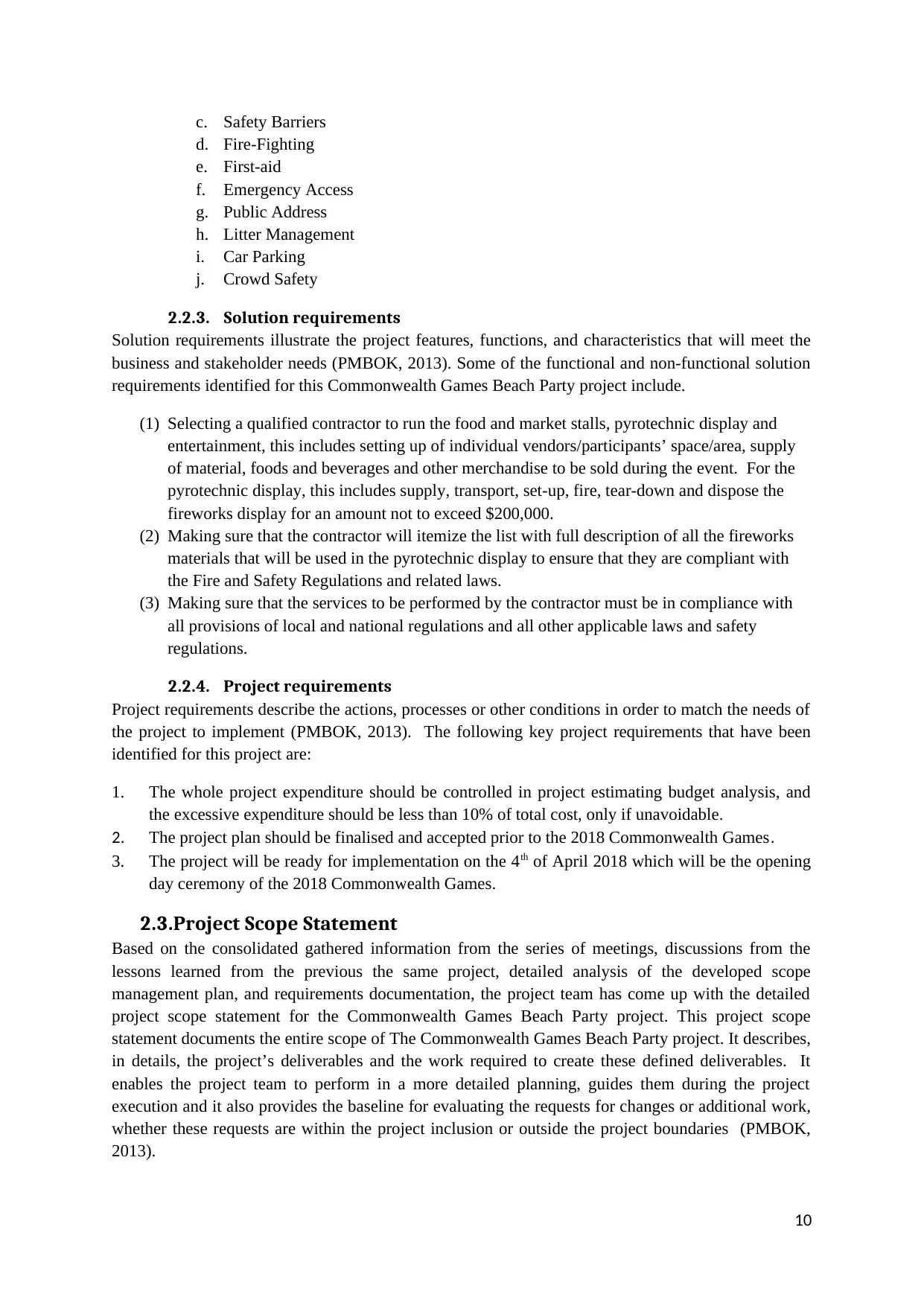
c. Safety Barriers
d. Fire-Fighting
e. First-aid
f. Emergency Access
g. Public Address
h. Litter Management
i. Car Parking
j. Crowd Safety
2.2.3. Solution requirements
Solution requirements illustrate the project features, functions, and characteristics that will meet the
business and stakeholder needs (PMBOK, 2013). Some of the functional and non-functional solution
requirements identified for this Commonwealth Games Beach Party project include.
(1) Selecting a qualified contractor to run the food and market stalls, pyrotechnic display and
entertainment, this includes setting up of individual vendors/participants’ space/area, supply
of material, foods and beverages and other merchandise to be sold during the event. For the
pyrotechnic display, this includes supply, transport, set-up, fire, tear-down and dispose the
fireworks display for an amount not to exceed $200,000.
(2) Making sure that the contractor will itemize the list with full description of all the fireworks
materials that will be used in the pyrotechnic display to ensure that they are compliant with
the Fire and Safety Regulations and related laws.
(3) Making sure that the services to be performed by the contractor must be in compliance with
all provisions of local and national regulations and all other applicable laws and safety
regulations.
2.2.4. Project requirements
Project requirements describe the actions, processes or other conditions in order to match the needs of
the project to implement (PMBOK, 2013). The following key project requirements that have been
identified for this project are:
1. The whole project expenditure should be controlled in project estimating budget analysis, and
the excessive expenditure should be less than 10% of total cost, only if unavoidable.
2. The project plan should be finalised and accepted prior to the 2018 Commonwealth Games.
3. The project will be ready for implementation on the 4th of April 2018 which will be the opening
day ceremony of the 2018 Commonwealth Games.
2.3.Project Scope Statement
Based on the consolidated gathered information from the series of meetings, discussions from the
lessons learned from the previous the same project, detailed analysis of the developed scope
management plan, and requirements documentation, the project team has come up with the detailed
project scope statement for the Commonwealth Games Beach Party project. This project scope
statement documents the entire scope of The Commonwealth Games Beach Party project. It describes,
in details, the project’s deliverables and the work required to create these defined deliverables. It
enables the project team to perform in a more detailed planning, guides them during the project
execution and it also provides the baseline for evaluating the requests for changes or additional work,
whether these requests are within the project inclusion or outside the project boundaries (PMBOK,
2013).
10
d. Fire-Fighting
e. First-aid
f. Emergency Access
g. Public Address
h. Litter Management
i. Car Parking
j. Crowd Safety
2.2.3. Solution requirements
Solution requirements illustrate the project features, functions, and characteristics that will meet the
business and stakeholder needs (PMBOK, 2013). Some of the functional and non-functional solution
requirements identified for this Commonwealth Games Beach Party project include.
(1) Selecting a qualified contractor to run the food and market stalls, pyrotechnic display and
entertainment, this includes setting up of individual vendors/participants’ space/area, supply
of material, foods and beverages and other merchandise to be sold during the event. For the
pyrotechnic display, this includes supply, transport, set-up, fire, tear-down and dispose the
fireworks display for an amount not to exceed $200,000.
(2) Making sure that the contractor will itemize the list with full description of all the fireworks
materials that will be used in the pyrotechnic display to ensure that they are compliant with
the Fire and Safety Regulations and related laws.
(3) Making sure that the services to be performed by the contractor must be in compliance with
all provisions of local and national regulations and all other applicable laws and safety
regulations.
2.2.4. Project requirements
Project requirements describe the actions, processes or other conditions in order to match the needs of
the project to implement (PMBOK, 2013). The following key project requirements that have been
identified for this project are:
1. The whole project expenditure should be controlled in project estimating budget analysis, and
the excessive expenditure should be less than 10% of total cost, only if unavoidable.
2. The project plan should be finalised and accepted prior to the 2018 Commonwealth Games.
3. The project will be ready for implementation on the 4th of April 2018 which will be the opening
day ceremony of the 2018 Commonwealth Games.
2.3.Project Scope Statement
Based on the consolidated gathered information from the series of meetings, discussions from the
lessons learned from the previous the same project, detailed analysis of the developed scope
management plan, and requirements documentation, the project team has come up with the detailed
project scope statement for the Commonwealth Games Beach Party project. This project scope
statement documents the entire scope of The Commonwealth Games Beach Party project. It describes,
in details, the project’s deliverables and the work required to create these defined deliverables. It
enables the project team to perform in a more detailed planning, guides them during the project
execution and it also provides the baseline for evaluating the requests for changes or additional work,
whether these requests are within the project inclusion or outside the project boundaries (PMBOK,
2013).
10
Paraphrase This Document
Need a fresh take? Get an instant paraphrase of this document with our AI Paraphraser
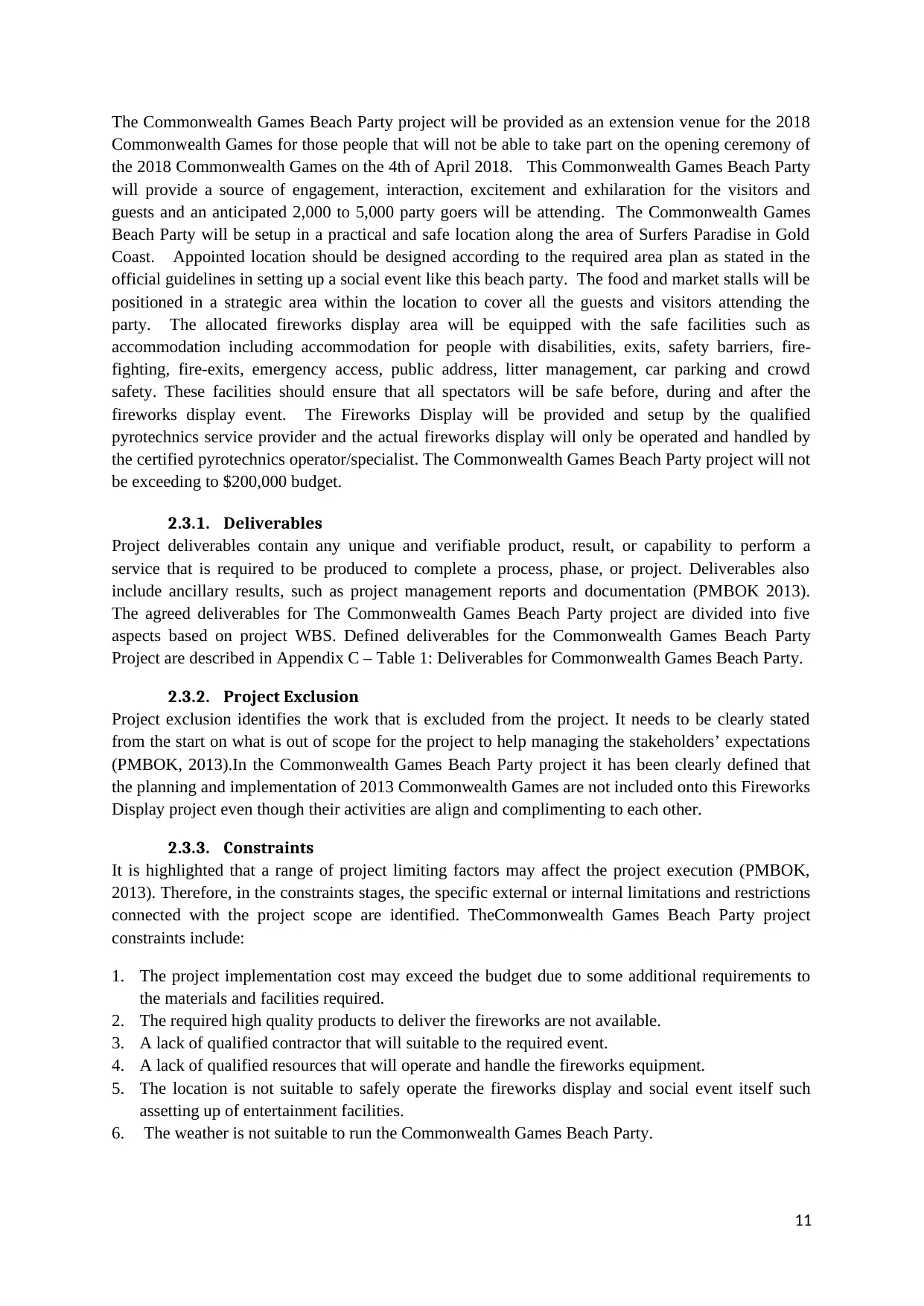
The Commonwealth Games Beach Party project will be provided as an extension venue for the 2018
Commonwealth Games for those people that will not be able to take part on the opening ceremony of
the 2018 Commonwealth Games on the 4th of April 2018. This Commonwealth Games Beach Party
will provide a source of engagement, interaction, excitement and exhilaration for the visitors and
guests and an anticipated 2,000 to 5,000 party goers will be attending. The Commonwealth Games
Beach Party will be setup in a practical and safe location along the area of Surfers Paradise in Gold
Coast. Appointed location should be designed according to the required area plan as stated in the
official guidelines in setting up a social event like this beach party. The food and market stalls will be
positioned in a strategic area within the location to cover all the guests and visitors attending the
party. The allocated fireworks display area will be equipped with the safe facilities such as
accommodation including accommodation for people with disabilities, exits, safety barriers, fire-
fighting, fire-exits, emergency access, public address, litter management, car parking and crowd
safety. These facilities should ensure that all spectators will be safe before, during and after the
fireworks display event. The Fireworks Display will be provided and setup by the qualified
pyrotechnics service provider and the actual fireworks display will only be operated and handled by
the certified pyrotechnics operator/specialist. The Commonwealth Games Beach Party project will not
be exceeding to $200,000 budget.
2.3.1. Deliverables
Project deliverables contain any unique and verifiable product, result, or capability to perform a
service that is required to be produced to complete a process, phase, or project. Deliverables also
include ancillary results, such as project management reports and documentation (PMBOK 2013).
The agreed deliverables for The Commonwealth Games Beach Party project are divided into five
aspects based on project WBS. Defined deliverables for the Commonwealth Games Beach Party
Project are described in Appendix C – Table 1: Deliverables for Commonwealth Games Beach Party.
2.3.2. Project Exclusion
Project exclusion identifies the work that is excluded from the project. It needs to be clearly stated
from the start on what is out of scope for the project to help managing the stakeholders’ expectations
(PMBOK, 2013).In the Commonwealth Games Beach Party project it has been clearly defined that
the planning and implementation of 2013 Commonwealth Games are not included onto this Fireworks
Display project even though their activities are align and complimenting to each other.
2.3.3. Constraints
It is highlighted that a range of project limiting factors may affect the project execution (PMBOK,
2013). Therefore, in the constraints stages, the specific external or internal limitations and restrictions
connected with the project scope are identified. TheCommonwealth Games Beach Party project
constraints include:
1. The project implementation cost may exceed the budget due to some additional requirements to
the materials and facilities required.
2. The required high quality products to deliver the fireworks are not available.
3. A lack of qualified contractor that will suitable to the required event.
4. A lack of qualified resources that will operate and handle the fireworks equipment.
5. The location is not suitable to safely operate the fireworks display and social event itself such
assetting up of entertainment facilities.
6. The weather is not suitable to run the Commonwealth Games Beach Party.
11
Commonwealth Games for those people that will not be able to take part on the opening ceremony of
the 2018 Commonwealth Games on the 4th of April 2018. This Commonwealth Games Beach Party
will provide a source of engagement, interaction, excitement and exhilaration for the visitors and
guests and an anticipated 2,000 to 5,000 party goers will be attending. The Commonwealth Games
Beach Party will be setup in a practical and safe location along the area of Surfers Paradise in Gold
Coast. Appointed location should be designed according to the required area plan as stated in the
official guidelines in setting up a social event like this beach party. The food and market stalls will be
positioned in a strategic area within the location to cover all the guests and visitors attending the
party. The allocated fireworks display area will be equipped with the safe facilities such as
accommodation including accommodation for people with disabilities, exits, safety barriers, fire-
fighting, fire-exits, emergency access, public address, litter management, car parking and crowd
safety. These facilities should ensure that all spectators will be safe before, during and after the
fireworks display event. The Fireworks Display will be provided and setup by the qualified
pyrotechnics service provider and the actual fireworks display will only be operated and handled by
the certified pyrotechnics operator/specialist. The Commonwealth Games Beach Party project will not
be exceeding to $200,000 budget.
2.3.1. Deliverables
Project deliverables contain any unique and verifiable product, result, or capability to perform a
service that is required to be produced to complete a process, phase, or project. Deliverables also
include ancillary results, such as project management reports and documentation (PMBOK 2013).
The agreed deliverables for The Commonwealth Games Beach Party project are divided into five
aspects based on project WBS. Defined deliverables for the Commonwealth Games Beach Party
Project are described in Appendix C – Table 1: Deliverables for Commonwealth Games Beach Party.
2.3.2. Project Exclusion
Project exclusion identifies the work that is excluded from the project. It needs to be clearly stated
from the start on what is out of scope for the project to help managing the stakeholders’ expectations
(PMBOK, 2013).In the Commonwealth Games Beach Party project it has been clearly defined that
the planning and implementation of 2013 Commonwealth Games are not included onto this Fireworks
Display project even though their activities are align and complimenting to each other.
2.3.3. Constraints
It is highlighted that a range of project limiting factors may affect the project execution (PMBOK,
2013). Therefore, in the constraints stages, the specific external or internal limitations and restrictions
connected with the project scope are identified. TheCommonwealth Games Beach Party project
constraints include:
1. The project implementation cost may exceed the budget due to some additional requirements to
the materials and facilities required.
2. The required high quality products to deliver the fireworks are not available.
3. A lack of qualified contractor that will suitable to the required event.
4. A lack of qualified resources that will operate and handle the fireworks equipment.
5. The location is not suitable to safely operate the fireworks display and social event itself such
assetting up of entertainment facilities.
6. The weather is not suitable to run the Commonwealth Games Beach Party.
11
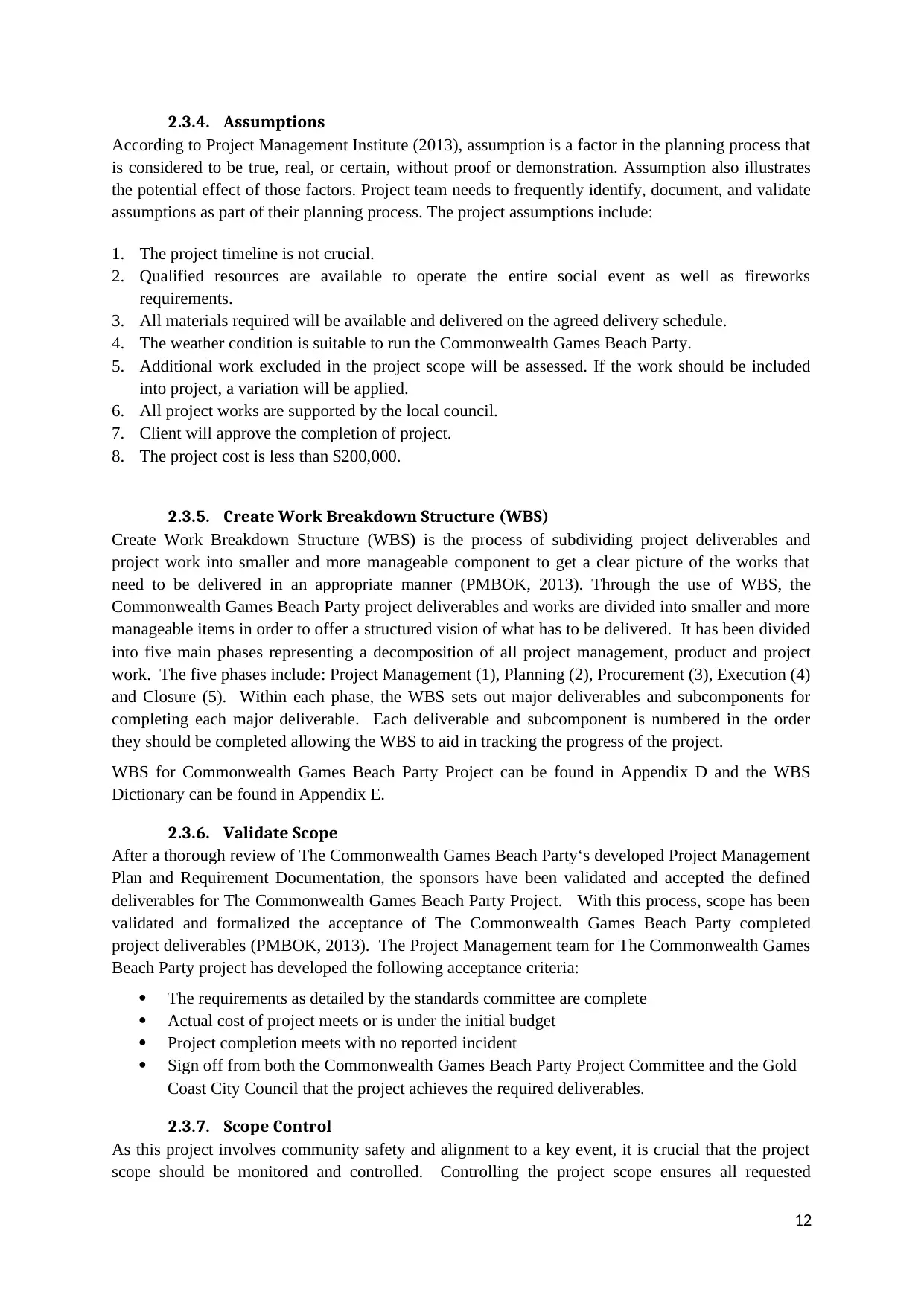
2.3.4. Assumptions
According to Project Management Institute (2013), assumption is a factor in the planning process that
is considered to be true, real, or certain, without proof or demonstration. Assumption also illustrates
the potential effect of those factors. Project team needs to frequently identify, document, and validate
assumptions as part of their planning process. The project assumptions include:
1. The project timeline is not crucial.
2. Qualified resources are available to operate the entire social event as well as fireworks
requirements.
3. All materials required will be available and delivered on the agreed delivery schedule.
4. The weather condition is suitable to run the Commonwealth Games Beach Party.
5. Additional work excluded in the project scope will be assessed. If the work should be included
into project, a variation will be applied.
6. All project works are supported by the local council.
7. Client will approve the completion of project.
8. The project cost is less than $200,000.
2.3.5. Create Work Breakdown Structure (WBS)
Create Work Breakdown Structure (WBS) is the process of subdividing project deliverables and
project work into smaller and more manageable component to get a clear picture of the works that
need to be delivered in an appropriate manner (PMBOK, 2013). Through the use of WBS, the
Commonwealth Games Beach Party project deliverables and works are divided into smaller and more
manageable items in order to offer a structured vision of what has to be delivered. It has been divided
into five main phases representing a decomposition of all project management, product and project
work. The five phases include: Project Management (1), Planning (2), Procurement (3), Execution (4)
and Closure (5). Within each phase, the WBS sets out major deliverables and subcomponents for
completing each major deliverable. Each deliverable and subcomponent is numbered in the order
they should be completed allowing the WBS to aid in tracking the progress of the project.
WBS for Commonwealth Games Beach Party Project can be found in Appendix D and the WBS
Dictionary can be found in Appendix E.
2.3.6. Validate Scope
After a thorough review of The Commonwealth Games Beach Party‘s developed Project Management
Plan and Requirement Documentation, the sponsors have been validated and accepted the defined
deliverables for The Commonwealth Games Beach Party Project. With this process, scope has been
validated and formalized the acceptance of The Commonwealth Games Beach Party completed
project deliverables (PMBOK, 2013). The Project Management team for The Commonwealth Games
Beach Party project has developed the following acceptance criteria:
The requirements as detailed by the standards committee are complete
Actual cost of project meets or is under the initial budget
Project completion meets with no reported incident
Sign off from both the Commonwealth Games Beach Party Project Committee and the Gold
Coast City Council that the project achieves the required deliverables.
2.3.7. Scope Control
As this project involves community safety and alignment to a key event, it is crucial that the project
scope should be monitored and controlled. Controlling the project scope ensures all requested
12
According to Project Management Institute (2013), assumption is a factor in the planning process that
is considered to be true, real, or certain, without proof or demonstration. Assumption also illustrates
the potential effect of those factors. Project team needs to frequently identify, document, and validate
assumptions as part of their planning process. The project assumptions include:
1. The project timeline is not crucial.
2. Qualified resources are available to operate the entire social event as well as fireworks
requirements.
3. All materials required will be available and delivered on the agreed delivery schedule.
4. The weather condition is suitable to run the Commonwealth Games Beach Party.
5. Additional work excluded in the project scope will be assessed. If the work should be included
into project, a variation will be applied.
6. All project works are supported by the local council.
7. Client will approve the completion of project.
8. The project cost is less than $200,000.
2.3.5. Create Work Breakdown Structure (WBS)
Create Work Breakdown Structure (WBS) is the process of subdividing project deliverables and
project work into smaller and more manageable component to get a clear picture of the works that
need to be delivered in an appropriate manner (PMBOK, 2013). Through the use of WBS, the
Commonwealth Games Beach Party project deliverables and works are divided into smaller and more
manageable items in order to offer a structured vision of what has to be delivered. It has been divided
into five main phases representing a decomposition of all project management, product and project
work. The five phases include: Project Management (1), Planning (2), Procurement (3), Execution (4)
and Closure (5). Within each phase, the WBS sets out major deliverables and subcomponents for
completing each major deliverable. Each deliverable and subcomponent is numbered in the order
they should be completed allowing the WBS to aid in tracking the progress of the project.
WBS for Commonwealth Games Beach Party Project can be found in Appendix D and the WBS
Dictionary can be found in Appendix E.
2.3.6. Validate Scope
After a thorough review of The Commonwealth Games Beach Party‘s developed Project Management
Plan and Requirement Documentation, the sponsors have been validated and accepted the defined
deliverables for The Commonwealth Games Beach Party Project. With this process, scope has been
validated and formalized the acceptance of The Commonwealth Games Beach Party completed
project deliverables (PMBOK, 2013). The Project Management team for The Commonwealth Games
Beach Party project has developed the following acceptance criteria:
The requirements as detailed by the standards committee are complete
Actual cost of project meets or is under the initial budget
Project completion meets with no reported incident
Sign off from both the Commonwealth Games Beach Party Project Committee and the Gold
Coast City Council that the project achieves the required deliverables.
2.3.7. Scope Control
As this project involves community safety and alignment to a key event, it is crucial that the project
scope should be monitored and controlled. Controlling the project scope ensures all requested
12
⊘ This is a preview!⊘
Do you want full access?
Subscribe today to unlock all pages.

Trusted by 1+ million students worldwide
1 out of 64
Related Documents
Your All-in-One AI-Powered Toolkit for Academic Success.
+13062052269
info@desklib.com
Available 24*7 on WhatsApp / Email
![[object Object]](/_next/static/media/star-bottom.7253800d.svg)
Unlock your academic potential
Copyright © 2020–2025 A2Z Services. All Rights Reserved. Developed and managed by ZUCOL.



